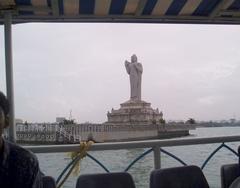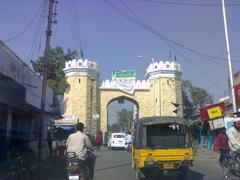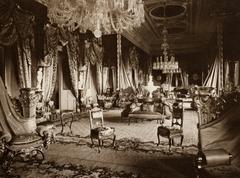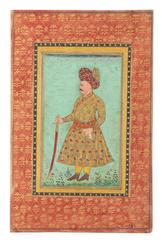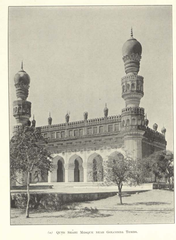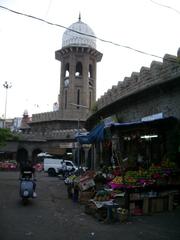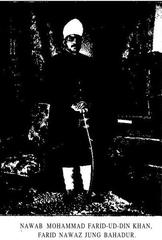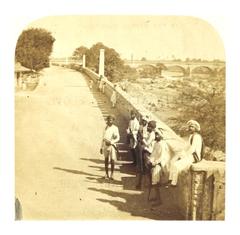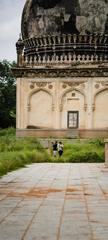
Osmania University Visiting Hours, Tickets, and Hyderabad Historical Sites Guide
Date: 03/07/2025
Introduction: Osmania University’s Heritage and Significance
Osmania University, founded in 1918 by Nawab Mir Osman Ali Khan, the seventh Nizam of Hyderabad, stands as a pillar of Indian higher education and a landmark of Hyderabad’s architectural and cultural landscape. Established with the progressive vision of using Urdu as the medium of instruction, Osmania University democratized advanced education for the region’s populace and set a new precedent in Indian academia (Osmania University Historical Tour; The News Minute). Sprawling over approximately 1,600 acres, the campus is renowned for its synthesis of Indo-Islamic, European, and Hindu architectural styles, most notably embodied in the iconic Arts College building—a trademarked heritage site designed by Belgian architect Ernest Jasper and supervised by Nawab Zain Yar Jung (Siasat; The Hans India).
Osmania University is more than an academic institution: it is a living museum of history, architecture, and ecological diversity. With a distinguished alumni network and a central role in the historical and social movements of Telangana, the university is a compelling destination for tourists, students, historians, and architecture enthusiasts. Its accessible campus, free entry to most areas, and proximity to Hyderabad’s major historical sites like Charminar and Golconda Fort make it a must-visit site for anyone exploring the city (Times Higher Education; Wikiwand).
This comprehensive guide offers key information on visiting hours, ticketing, campus navigation, and travel tips, ensuring you make the most of your visit to Osmania University and nearby Hyderabad historical sites.
Table of Contents
- Founding and Early Development
- Architectural and Cultural Synthesis
- Academic Growth and National Impact
- Language, Identity, and Social Change
- Role in Regional and National Movements
- Recognition and Rankings
- Visiting Osmania University: Hours, Tickets, and Travel Tips
- Architectural Highlights: The Arts College and Other Notable Structures
- Campus Green Spaces and Ecological Features
- Visitor Information: Entry, Tours, Accessibility, Facilities
- Nearby Attractions
- Tips for an Enjoyable Visit
- Frequently Asked Questions (FAQ)
- Summary and Call to Action
- Sources
Founding and Early Development
Osmania University was established by royal decree in 1918, spearheaded by Nawab Mir Osman Ali Khan and championed by Sir Akbar Hydari (Wikiwand; Osmania University Historical Tour). The vision was to offer higher education in Urdu, breaking away from British-imposed English instruction and making university learning more accessible to the region’s populace (The News Minute). The university started in temporary quarters near Nizam College, with initial faculties in Arts and Theology. Urdu was the primary instruction language, with English as a compulsory subject—a decision that was both cultural and political.
Architectural and Cultural Synthesis
The university’s permanent campus was planned after surveys by Patrick Geddes and design proposals by Ernest Jasper, with the foundation stone laid in 1934. The architectural style blends Indo-Islamic, European, and Hindu motifs, exemplified by the Arts College building. This synthesis of styles symbolizes the university’s secular vision and commitment to inclusivity (Osmania University Historical Tour; Siasat). The lush 1,600-acre campus includes 70 acres of gardens and a deer park, providing a tranquil setting for study and reflection (StuMagz).
Academic Growth and National Impact
Osmania University is the seventh oldest in India and the third oldest in South India (Osmania University). It now comprises 12 faculties and 53 departments, offering a wide array of undergraduate, postgraduate, and doctoral programs (Times Higher Education). With over 300,000 students across affiliated colleges, Osmania stands as one of the world’s largest academic networks (Wikiwand; StuMagz). Distinguished alumni include former Prime Minister P.V. Narasimha Rao and astronaut Rakesh Sharma (The News Minute).
Language, Identity, and Social Change
Osmania University’s adoption of Urdu as its medium of instruction marked a significant step in fostering cultural pride and educational accessibility, while retaining English to maintain global relevance (The News Minute). This approach was praised by Rabindranath Tagore and encapsulates the university’s motto: “Tamso Ma Jyotirgamaya” (Lead us from darkness to light) (Hillsdale.edu). The university remains a center of cultural, social, and academic integration.
Role in Regional and National Movements
Osmania University has played a central role in the socio-political landscape of Telangana. The campus was a hub during the Telangana statehood movement, with students and faculty at the forefront of activism (The News Minute). Today, it hosts thousands of students, including many from abroad, reflecting its global appeal and lasting impact (Wikiwand).
Recognition and Rankings
Osmania University has been recognized with the NAAC’s ‘A+’ grade and five-star status (Osmania University; StuMagz). It ranks 43rd nationally in the NIRF and is the top university in Telangana. It also features in the top 1400 of the QS World University Rankings and in the Times Higher Education World University Rankings (Times Higher Education).
Visiting Osmania University: Hours, Tickets, and Travel Tips
Visiting Hours and Entry
- Campus Hours: 9:00 AM to 5:00 PM, Monday through Saturday.
- Entry Fee: None for general campus access. Some special exhibitions or events may have separate charges.
- Guided Tours: Available by prior arrangement and during special events. Contact the visitor center or university administration for details.
How to Reach
- Location: Tarnaka, Hyderabad.
- Public Transport: Accessible via Hyderabad Metro (nearest station: Osmania University Metro Station, Blue Line), city buses, and auto-rickshaws.
- Parking: Ample parking is available at the main entrance.
Accessibility
The campus features ramps, accessible restrooms, and designated pathways to facilitate a comfortable visit for all guests.
Nearby Attractions
While at Osmania University, plan to explore Charminar, Golconda Fort, Salar Jung Museum, Sultan Bazaar, and the Telangana State Archaeology Museum. These can complete a full day’s heritage tour of Hyderabad.
Architectural Highlights: The Arts College and Other Notable Structures
The Iconic Arts College Building
- Design: By Ernest Jasper, inaugurated in 1939 (Siasat).
- Style: Blend of Qutub Shahi, Mughal, Kakatiya, Ajanta-Ellora, and Indo-Saracenic motifs (The Hindu).
- Materials: Locally sourced pink granite; characterized by vaulted roofs, domes, cupolas, and stained glass.
- Symbolism: A secular space celebrating Hyderabad’s pluralistic culture.
Trademark Recognition
In April 2025, the Arts College building became India’s third structure to receive trademark protection, ensuring its preservation and official image rights (The Hans India; Hyderabad Mail).
Other Notable Campus Structures
- Nizam College (1887): Colonial-era design with high ceilings and spacious verandahs (Osmania University).
- University College of Science, Saifabad (1951): Functional design, landscape integration.
- PG College of Law, Basheerbagh (1983): Combines modern facilities with traditional elements.
Campus Green Spaces and Ecological Features
- Botanical Garden: Open 11:00 AM – 6:00 PM, features native and exotic plants (iDiva).
- Deer Park: Home to over 200 deer.
- Birdlife: Frequent sightings of peacocks and other species (Siasat).
Visitor Information: Entry, Tours, Accessibility, Facilities
- Opening Hours: 9:00 AM to 5:00 PM, Monday through Saturday.
- Entry Fee: None for general campus access.
- Guided Tours: Can be arranged for groups and during special events.
- Accessibility: Wheelchair-friendly paths and ramps; accessible restrooms provided.
- Facilities: Restrooms, drinking water stations, canteens, free Wi-Fi, and cafeterias serving local cuisine.
- Photography: Permitted in outdoor areas; check for restrictions in academic zones.
Tips for an Enjoyable Visit
- Plan for Weekdays: The campus is more active and vibrant.
- Wear Comfortable Footwear: The campus is expansive and walking is essential.
- Carry ID: Required for security checks.
- Best Time to Visit: October to March for pleasant weather; early mornings and late afternoons for photography.
- Combine with Local Sights: RTC X-Roads, Sultan Bazaar, and Hyderabad’s famous eateries nearby (Collegedunia; The Tourist Checklist).
- Respect Etiquette: Observe campus rules and maintain decorum.
Frequently Asked Questions (FAQ)
Q: What are the Osmania University visiting hours?
A: 9:00 AM to 5:00 PM, Monday to Saturday.
Q: Is there an entry fee?
A: No, entry is free for general campus access.
Q: Are guided tours available?
A: Yes, by prior arrangement and during special events.
Q: Is the campus accessible for people with disabilities?
A: Yes, with ramps and accessible facilities.
Q: Can I take photographs?
A: Yes, in most outdoor areas; check for any restrictions.
Q: Are there places to eat on campus?
A: Several canteens and cafeterias are available.
Q: What is the best season to visit?
A: October to March, during Hyderabad’s cooler months.
Summary and Call to Action
Osmania University is a beacon of educational and cultural excellence in Hyderabad, offering a unique blend of history, architecture, ecology, and vibrant student life. Its free public access, iconic Arts College building, lush gardens, and central location make it an essential stop for anyone exploring Hyderabad’s heritage (Osmania University Historical Tour; Siasat).
For the latest updates on visiting hours, events, and tours, download the Audiala app, explore our related Hyderabad guides, and follow us on social media for exclusive content and travel resources.
Sources
- Osmania University Historical Tour
- The News Minute
- Wikiwand
- Siasat
- The Hans India
- Osmania University
- Triphobo
- Times Higher Education
- StuMagz
- iDiva
- Collegedunia
- The Tourist Checklist
- Hillsdale.edu
- Hyderabad Mail







